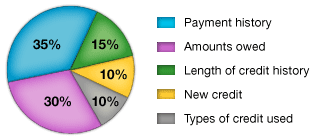In the first part of our What’s Your Credit Score? post, STACKS Magazine introduced the FICO and explored the description of what it meant. Now let’s go a little further and breakdown the philosophy of the FICO and see how this information can help you achieve your credit score goals.

The FICO score is a system that calculates your score based on several different areas: payment history, amounts owed, length of credit history, new credit, and the types of credit used. The most important category is your payment history. In order to determine why your current score is average or below average, you must first recognize the areas in which you suffer. The details in each category will help you spot those issues and give you further insight on why your credit score is not at it’s highest. Payment History, the following is determined:
Under your
- Account payment information on specific types of accounts (credit cards, retail accounts, installment loans, finance company accounts, mortgage, etc.)
- Presence of adverse public records (bankruptcy, judgements, suits, liens, wage attachments, etc.), collection items, and/or delinquency (past due items)
- Severity of delinquency (how long past due)
- Amount past due on delinquent accounts or collection items
- Time since (recency of) past due items (delinquency), adverse public records (if any), or collection items (if any)
- Number of past due items on file
- Number of accounts paid as agreed
While the remaining categories are defined as such…
Amounts Owed
- Amount owing on accounts
- Amount owing on specific types of accounts
- Lack of a specific type of balance, in some cases
- Number of accounts with balances
- Proportion of credit lines used (proportion of balances to total credit limits on certain types of revolving accounts)
- Proportion of installment loan amounts still owing (proportion of balance to original loan amount on certain types of installment loans)
Length of Credit History
- Time since accounts opened
- Time since accounts opened, by specific type of account
- Time since account activity
New Credit
- Number of recently opened accounts, and proportion of accounts that are recently opened, by type of account
- Number of recent credit inquiries
- Time since recent account opening(s), by type of account
- Time since credit inquiry(s)
- Re-establishment of positive credit history following past payment problems
Types of Credit Used
- Number of (presence, prevalence, and recent information on) various types of accounts (credit cards, retail accounts, installment loans, mortgage, consumer finance accounts, etc.)
Now do you understand how the FICO scoring system works? If so, then you should understand why creditors, finance companies, and even some job human resource departments take a look at your credit score before approving you for anything. This score is an important lifeline. Without it, positive or negative, your life experiences can be put at a standstill (whether it’s not being able to purchase that new dream home or trying to apply for a small business loan). You need a decent credit score to achieve any of these things.
So get on the move! It’s 2009 and it is time for your financial habits to change. It is time for you to improve your credit score. Stay tuned as we continue to explore the FICO score and ways to maintain that good standing.

